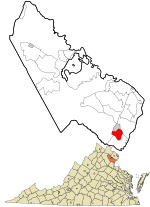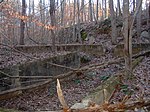Weems–Botts Museum

Weems–Botts House Museum is a small historic museum in Dumfries, Virginia, United States. The museum includes the landmark Weems–Botts House on the corner of Duke Street and Cameron Street and the Weems–Botts Museum Annex, which houses the Lee Lansing Research Library and Archive, located at 3944 Cameron Street. Both buildings are located in Merchant Park. The park's bandstand commemorates William Grayson, one of Prince William County's most respected citizens and one of Virginia's first senators. The museum tour showcases the history of Dumfries, Virginia's oldest chartered town, and people associated with the house, including Mason Locke "Parson" Weems, and attorney Benjamin Botts.The museum was restored in 1975 as part of a bicentennial U.S. restoration project. The museum is owned by the Town of Dumfries and operated by Historic Dumfries Virginia, Inc., a non-profit organization.
Excerpt from the Wikipedia article Weems–Botts Museum (License: CC BY-SA 3.0, Authors, Images).Weems–Botts Museum
Cameron Street,
Geographical coordinates (GPS) Address Nearby Places Show on map
Geographical coordinates (GPS)
| Latitude | Longitude |
|---|---|
| N 38.568611111111 ° | E -77.330277777778 ° |
Address
Cameron Street
22026
Virginia, United States
Open on Google Maps






